Is there a more elegant way to cook than poaching technique? Picture this—egg whites set to silky perfection, vibrant fruits steeped in spiced syrups, or tender fish infused with delicate aromatics. Poaching technique may not grab the spotlight like grilling or roasting, but for those who know its secrets, it’s a quiet hero in the kitchen. Whether you’re a culinary novice or a seasoned home chef, this moist-heat cooking method offers a world of flavor, texture, and versatility worth exploring.
For anyone curious about unlocking poaching’s potential, this guide is for you. Together, we’ll uncover its history, science, benefits, and the foolproof techniques to take your cooking to the next level. And don’t worry—we’ve included some irresistible recipes to get you started!
What is Poaching Technique?
Poaching technique is a moist-heat cooking method that involves gently cooking food in a liquid at low temperatures (between 160°F and 180°F). Instead of the rolling bubbles of boiling, the process relies on a barely perceptible shimmer. The result? Foods that retain their delicate textures and nuanced flavors without drying out or becoming overcooked.
From eggs to fish and even fruits, poaching has been a staple technique in kitchens around the globe for centuries—and for good reason. It’s a simple yet sophisticated way to prepare healthy, flavorful dishes with little added fat.
Before we get into the how-to, let’s take a step back and explore where this gentle cooking method began.
A Brief History of Poaching Technique
Poaching technique has roots that reach deep into classic European cuisine. French culinary traditions, in particular, elevated poaching to an art form, with techniques used to create delicate dishes like poached fish in court-bouillon or the famous Oeufs Mollets. Over time, poaching became synonymous with refinement—a method celebrated by chefs for its ability to respect the natural integrity of ingredients.
But Western kitchens didn’t monopolize the technique. Poaching technique later spread globally, adapting to cultural preferences, from poached dumplings in Asia to sweet coconut-poached fruits in tropical cuisines. Today, the method continues to evolve, finding its place in modern kitchens as both a health-conscious and gastronomically appealing style of cooking.
The Science Behind Poaching Technique
What makes poaching technique so effective? It all comes down to precision and temperature control.
- Low Heat, Perfect Control: Poaching technique happens in the “sweet spot” of 160°F to 180°F. At this temperature, proteins gently denature without overcooking or becoming tough.
- The Role of Liquid: Poaching liquid—whether it’s water, stock, milk, or wine—is more than a cooking medium. It infuses subtle flavors into the food and can often be repurposed as broths or sauces.
- A Comparison to Other Methods: Unlike boiling or simmering (which rely on higher heat and active bubbling), poaching preserves delicate structures and prevents the leaching of nutrients, making it a preferred option for fragile ingredients.
Now that you know the science, let’s talk about why this method deserves a place in your cooking repertoire.
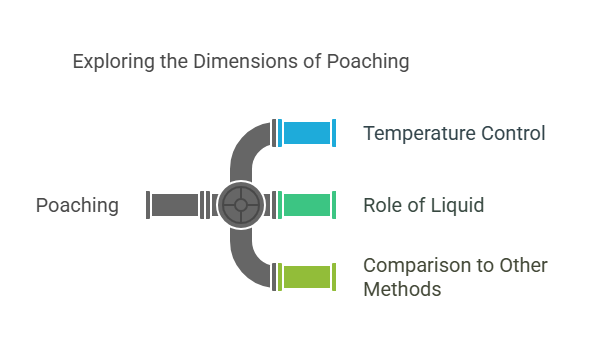
Benefits of Poaching
1. Health Benefits
If you’re looking for a clean, healthy way to prepare meals, poaching technique is hard to beat.
- Nutrient Retention: By avoiding high heat, poaching helps preserve important vitamins and minerals often lost in grilling or frying.
- Low in Fat: Because the method doesn’t rely on added oils or fats, it’s ideal for anyone conscious of their calorie or fat intake.
2. Culinary Benefits
Poaching technique works wonders with delicate ingredients like fish or eggs.
- It gently enhances flavors rather than masking them.
- Foods poached correctly turn out tender, juicy, and perfectly cooked (think buttery salmon or plump poached pears).
3. Versatility in the Kitchen
Whether you’re making a breakfast dish or dessert, poaching technique adapts to your needs.
- The liquid you use takes center stage. Want a savory dish? Poach in spiced stock. Craving sweetness? Try red wine or spiced syrups for fruits.
- Leftover poaching liquid can double as a soup base or sauce—talk about working smarter in the kitchen!
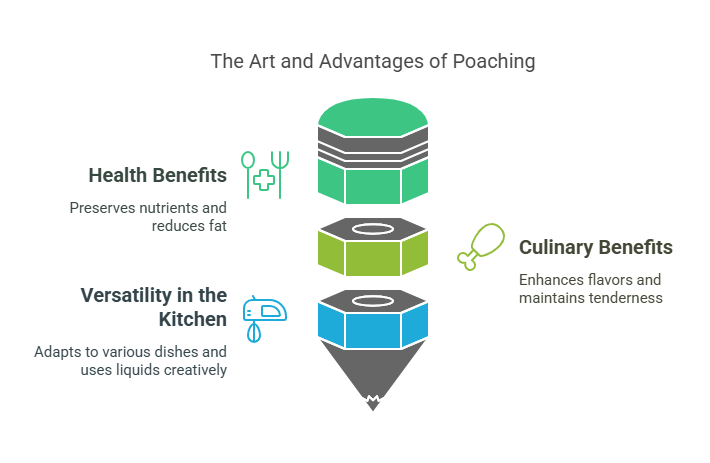
Poaching Techniques and Best Practices
A. How to Poach Like a Pro
Follow these straightforward steps to achieve consistent, flavorful results every time:
- Choose Your Liquid: Start with water, broth, or even milk. Add aromatics like herbs, spices, or citrus to enhance flavor.
- Prepare the Food: Trim and prep ingredients. For proteins, ensure they’re evenly portioned for uniform cooking.
- Control the Temperature: Use a thermometer to maintain 160°F to 180°F—this ensures gentle cooking. No thermometer? Look for a few wisps of steam, but no bubbles.
- Perfect Timing: Keep an eye on doneness. Check fish with a fork, or test the texture of fruits gently with a knife.
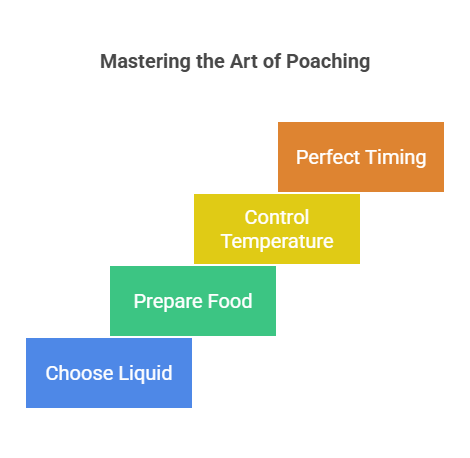
B. Types of Poaching Technique
1. Shallow Poaching
- Ideal for fish, like salmon or sole.
- Liquid only partially covers the food and often becomes the base for a sauce.
Example: Poached salmon with white wine and herbs.
2. Deep Poaching
- Immerses the food fully in liquid—perfect for eggs, chicken, or whole fruits.
Example: Poached eggs for a classic Benedict or poached pears in spiced red wine.
C. Mistakes to Avoid
Even experienced cooks can slip up with poaching. Avoid these common pitfalls:
- Too Hot to Handle: Overheating the liquid can ruin textures. Stick to a simmer, not a boil.
- No Flavor in the Liquid: Bland liquid = bland dish. Season liberally!
- Overcrowding: Keep plenty of space around individual items for even cooking.
- Wasting Poaching Liquid: Don’t toss it—repurpose it into something delicious.
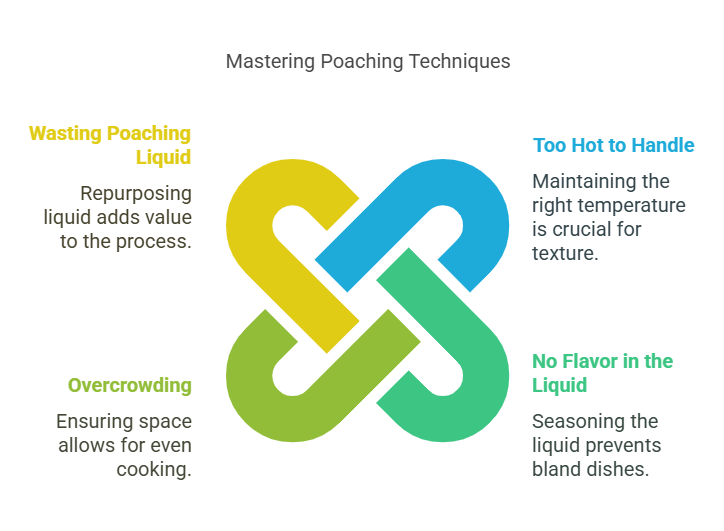
Poaching Technique Recipes to Try at Home
Savory Recipes
- Poached Eggs with Hollandaise Sauce
Master the swirling water method to make brunch-worthy eggs every time.
- Poached Chicken Breasts
Perfect for meal preppers—use aromatic poaching liquids to keep chicken flavorful for salads or soups.
- Shallow Poached Fish in White Wine
Impress dinner guests with this simple yet sophisticated recipe.
Sweet Recipes
- Poached Pears in Red Wine
Fruity, spiced, and decadently elegant—this one’s a showstopper.
- Vanilla Poached Apples
A healthy yet indulgent dessert option. Bonus? The poaching syrup can double as a glaze for cakes or pancakes!
Choosing Poaching Technique over Other Cooking Methods
You might wonder—when should you poach instead of boiling, simmering, or steaming? The answer depends on the ingredient and your final goal. Choose poaching technique when dealing with delicate foods where texture and flavor subtleties are key (like fish or fruit). Its gentleness and ability to infuse flavor make it a standout technique for nuanced dishes.
FAQs About Poaching
What foods can you poach?
Eggs, fish, chicken, fruits, and even dumplings are all great candidates.
Can I reuse poaching liquid?
Yes! Broth-based liquids can become soups, while sweeter ones make fantastic reductions and syrups.
Is poaching technique easy for beginners?
Absolutely. With a thermometer and a few simple steps, anyone can master the basics.
What’s the difference between poaching technique and boiling technique?
Temperature! Poaching uses low heat (160–180°F), while boiling is much hotter (212°F).
Wrapping It All Up
Poaching technique is a kitchen skill that brings elegance, healthfulness, and incredible flavor to the table. It’s perfect for busy home cooks, health-conscious eaters, and those who love experimenting with versatile techniques. From poached eggs for breakfast to poached fruit for dessert, the possibilities are endless.
Why not take this gentle cooking method for a spin? Start small. Try a poached egg, then level up to poached chicken or a decadent dessert. Have fun experimenting, and don’t forget to savor every bite!
📌 Stay connected with us!
- Follow us on Instagram: @RoastedKitchen25 for daily cooking inspiration.
- Tag us in your creations using #RoastedKitchenpoached—we’d love to see what you make!
- Subscribe to our newsletter for exclusive recipes, expert tips, and kitchen hacks straight to your inbox!

Hi, I’m Mayaz Ahsan!
As a passionate cook, storyteller, and food enthusiast, I combine my love for travel, farming, reading, and teaching to bring you insightful culinary tips and stories. Welcome to Roasted Kitchen – I’m thrilled to share this journey with you!

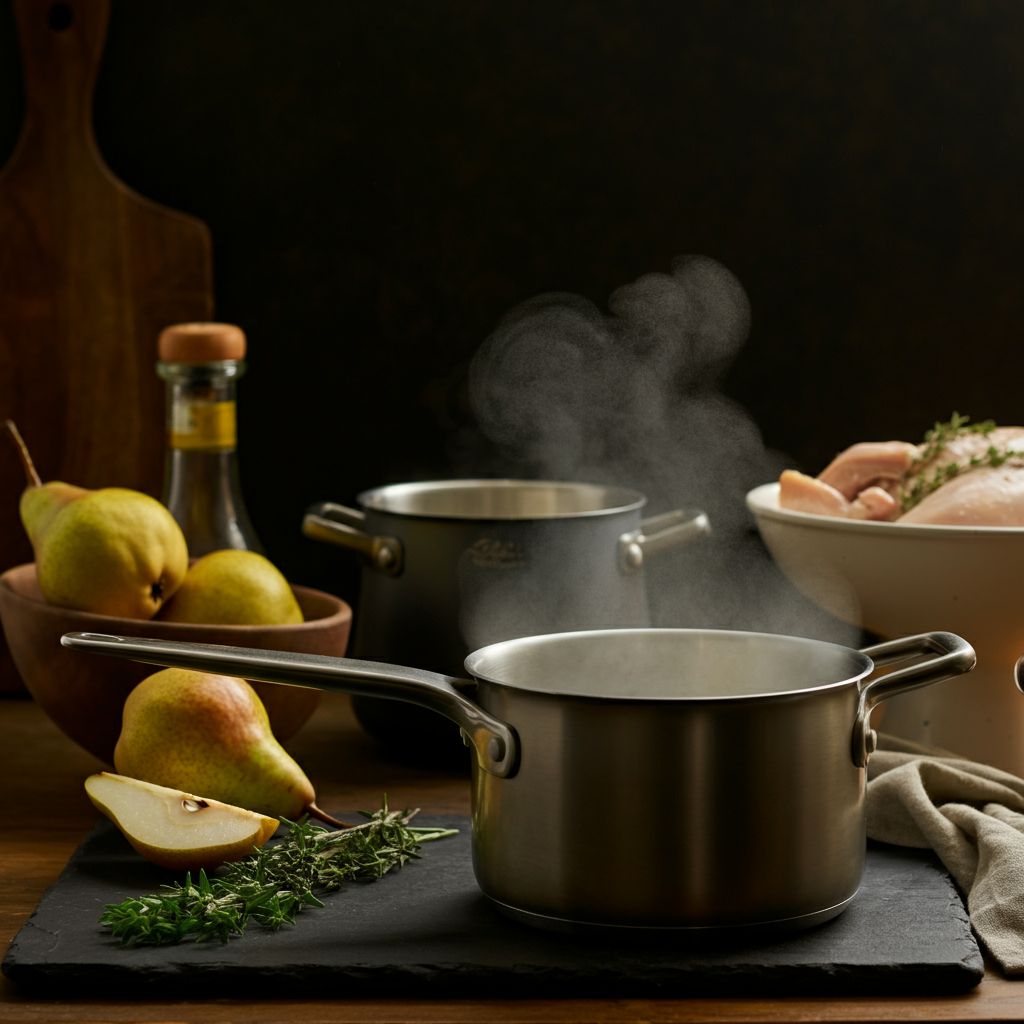








 Subscribe to our free newsletter for tips, tutorials, and insights!
Subscribe to our free newsletter for tips, tutorials, and insights!